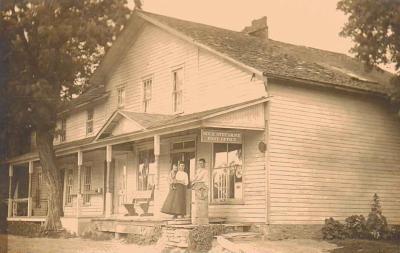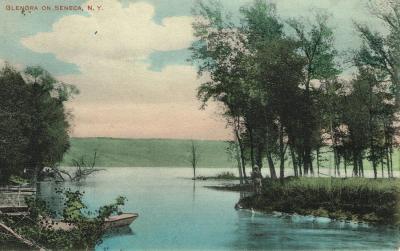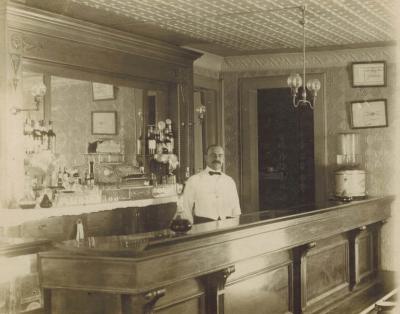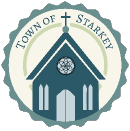
Welcome to Starkey
The Town of Starkey was created from a portion of the Town of Reading (then located in Steuben County) by an act of the New York State Legislature on April 6, 1824. The creation of the Town was effective after the census of 1825, and placed the newly created Town of Starkey in Yates County. The Town was named in honor of John Starkey, a prominent citizen. Early settlers in the Town of Starkey were primarily from southern New York, New Jersey, and Pennsylvania.
The Town of Starkey quickly developed into an industrial town with six crossroad settlements: Shannon’s Corners, Eddytown (Lakemont), Rock Stream, Starkey Corners, Harpending’s Corners (Dundee), and Big Stream Point (Glenora), with Eddytown being the largest settlement. By 1825 Starkey had a total of nine grist mills, sixteen saw mills, an oil mill, three fulling mills, four carding machines, three distilleries, and five asheries. Big Stream was the main source of water power for the mills. Seneca Lake was a shipping center and an established means of transportation. The area communities began building churches between 1822 and 1835, as well as the Starkey Seminary which was most recently Freedom Village.
During the Civil War, the Town of Starkey sent 118 men to war and 37 died in service. This left only 459 men between the ages of 18 and 45 in the Town. During this period, many farms raised fruit along with the usual cash crops. Much of the industry at the time was in the Village of Dundee. A railroad line was built through the Village in the 1870’s, and it too became a central shipping point.

By the mid 1870’s Big Stream Point was renamed Glenora, and it began to transform from an industrial center to a residential community. Many farms in the Town of Starkey engaged in full-scale fruit production, with grapes, raspberries, blackberries, quince, peaches, pears, and strawberries cultivated on many of the farms. The Town of Starkey was one of the first towns where large scale vineyards were established. Many other kinds of fruit were grown as well, and by the 1880’s the area was well known for 3 black raspberries. In addition to fruit, hops and tobacco were also grown in Starkey.
In the early 1900’s Starkey’s crossroad communities were still thriving, although changing. The Town was still largely involved in farming and, compared to other communities, was unusually prosperous with poultry and egg production entering the picture. The Town, as well as the county, was plagued during the 1920’s and 1930’s with a shortage of labor. Starkey had fewer vacant farms in 1939 than other towns, and a larger number of farms in the hands of original owners.
Prohibition did not affect the grape growers as much as it did the wineries. During Prohibition, a person could make 250 gallons of wine per person for home consumption. The Town of Starkey remained a “dry town” until 1957 when the voters approved a local option permitting the sale of alcoholic beverages for off-premise consumption, but voters turned down proposals to allow on-premise consumption in restaurants, or sale of packaged beer or liquor in stores, or sale of alcoholic beverages in hotels.

By 1933 Routes 14 and 14A, as well as the Lakemont-Himrod and Dundee-Himrod Roads, had been paved. Route 14 had been partially remade and no longer passed through Rock Stream or Starkey Station. During WWII, the Town of Starkey again suffered labor shortages, and much of the Town’s harvesting was accomplished with migrant labor. By the mid 1970’s the population of the Town of Starkey started to increase due to a surge in the farming community and development of lakefront property accessible by the State Route 14 corridor. Comprised of dwellings on both private and public roads, lakefront developments currently house both seasonal and full time residents bringing the full time population to 5370 with a seasonal influx of approximately 2500. This has been supported in part by the rapidly growing wine and tourism industries.
Scenic and historical sites within the Town of Starkey include The Starkey Methodist Church and Cemetery (1882 – Lakemont-Himrod Road), Dr. Henry Spence Cobblestone House (1848 - LakemontHimrod Road, presently Cobblestone Springs Retreat Center), The Rock and Big Stream Falls, Rock Stream Presbyterian Church and Memorial Hall (1865 and 1931), Enos Allen House (1815 – Old Lake Road), Peleg Briggs Wildlife Sanctuary (Log City Road), Simeon Royce House (1825 – Lakemont-Himrod Road at Hayes Road), the Timothy Hurd House (1810 – altered, Lakemont-Himrod Road), The Daniel Shannon House and Millsite (1825 – Lakemont-Himrod Road), and the Pierce-Mitchell Houses (1820-1840 – Route 14A).
